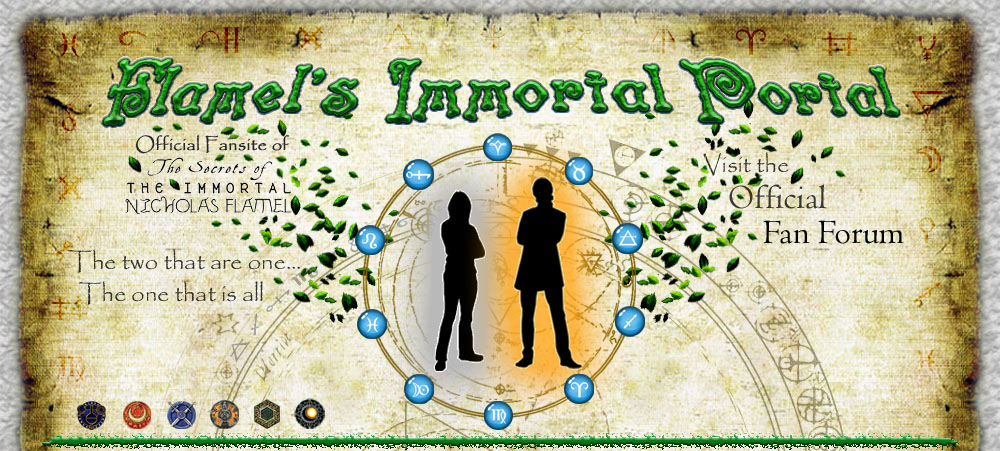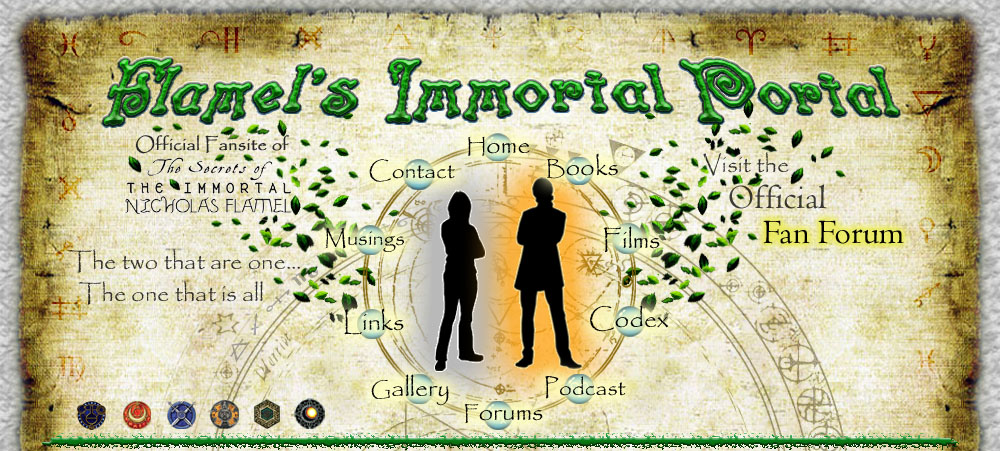| Home | l | Books | l | Films | l | Codex | l | Podcast | l | Forums | l | Gallery | l | Links | l | Musings | l | Contact |



|
King Tutankhamun is mentioned a couple of times in passing in the Alchemyst. Most notably of course is the fact that he was the last known owner of a golden aura, before Josh. Despite the fact Scathach says she has never met King Tut, we know there is a connection between the shadow warrior and the couple of Tutankhamun and Ankhesenamen. But perhaps in order to understand King Tut's deeper connection to the story, we need to delve into his life and the burial tomb of boy king. Tutankhaten, meaning living image of Aten, was born in 1341 BCE. His rule was estimated to begin at the age of 8, in Egypt's 18th dynasty, and he was thought to have died around the age of 19. He was married to his half sister Ankhesenpaaten, the daughter of Nefertiti. When Tutanhaten restored the religion of the Egyptians to the worship of Amun-Ra, the sun god, he changed his name to Tutankhamun, meaning living image of Amun, and similarly his wife Ankhesenpaaten changed her name to Ankhesenamen, meaning she who lives through Amun. Many statues depicting the couple often show them as transfigurations of the god Ra and his wife Mut, most likely as a direct result of the religious shift. This is important to note, because when Tutankhamun restored the religion to Ra, he also moved the civilization from the city of Thebes to the city of Memphis. Memphis, or the Mansion of Ptah, is situated in the Nile river delta, on the border of ancient Upper and Lower Egypt, and near present day Cairo. Memphis has also been mentioned to be missing the presence of the Bronze Age, which is an important fact I will return to later. Ptah, the god of craftsmen, pottery, and creation, was married to the lion goddess Sekhmet. Of the pair Sekhmet is the more interesting of the two, for many reasons. Sekhmet is often depicted in green with the head of a lion, beneath a solar disk. In addition, some of the titles she bears include the warrior goddess of Upper Egypt, and the goddess of the West, and she is often referred to as a solar deity. Her association with the sun's eye, or Ra, is said to give her the ability to bring drought or disaster to Egypt, and she is often worshipped as "the destroyer". The title of destroyer came about when Ra wanted to punish mankind, by sending Sekhmet, in the form of a lion, on a rampage spilling human blood. The site of the destruction of human life caused Ra to repent and order Sekhmet to stop, however her blood lust did not allow her to listen to Ra. In order to put an end to the carnage, Ra poured a mixture beer and pomegranate juice, which appeared like blood, in Sekhmet's path, and she gorged herself so much she fell into a deep sleep for three days. When she finally awoke the blood lust was gone, thus saving humanity. So this is proof of her ability to destroy. Sekhmet's many titles, and associations are significant because she has many dualities, a couple of which are worth discussing. The first, is her connection to the goddess Mut, who was earlier compared to the queen Ankhesenamen, bride of Tutankhamun. Sekhmet is said to be the aggressive side of Mut, or even that she was entirely absorbed into the goddess Mut. Regardless, the two goddesses as a duality are said to symbolize the unity of Egypt. Bastet is the second, and probably more interesting of the dualities of Sekhmet. Bastet the cat goddess, whom we known fairly well from the story and who has been confirmed to return in the Sorceress, is not only mentioned as a duality of Sekhmet but also believed in many cases to be her twin. The duality and the mention of the pair possibly being twins, is noteworthy on several accounts. First, we know the author has a fascination with twins, and we also know that the twins at the fall of Danu Talis are yet to be identified, not necessarily that Bastet and Sekhmet are those twins, but they do have many similarities. Secondly Bastet and Sekhmet are said to be the balance of one another. There is a consistent mention of that balance, the yin and yang, that can be found in statements such as, Bastet, the protector goddess of lower Egypt to Sekhmet the warrior goddess of Upper Egypt, Bastet the East to Sekhmet's West, Bastet the domestic cat compared to the wild lioness Sekhmet, and Bastet the lunar deity to Sekhmet the solar diety, to name a few. So the worship and religious beliefs of Tutankhamun and Ankhesenamen becomes the first possible link to the story. More evidence linking Tutankhamun to the series comes from examining his burial tomb from which there are several items of interest. In addition to those items, Scathach mentions that one reason many of the items he was buried with were made of gold was because of the color of his aura. Besides all the golden objects, a statue of Anubis was set to guard the tomb of Tutankhamun; specifically it was positioned in the room before Tut's sarcophagus. Anubis is said to be the son of Bastet, and again we have a link between Tut and the cat goddess. For the purposes of the story, we could perhaps say the tomb is not a burial site but a jail or holding cell for one King Tut immortal guarded by Anubis the god of the dead. Perhaps more fascinating than the statue of Anubis, are two daggers also found in the tomb. They are worth pointing out because they are similar in size to the swords of Excalibur and Clarent mentioned in the series. The two daggers buried with King Tut, are one of solid gold, and a second with a blade of iron. Both daggers could potentially be one of the two remaining elemental swords, but more importantly the second dagger has a blade of iron. The dagger with the iron blade could prove crucial to the back-story of the series in many ways. To begin with, we know iron is hazardous to all first generation elders, because it can nullify their magical abilities, which makes them very nervous. So here we have a potential immortal, King Tut walking around with weapon that not only can take away the elders' main source of power but also would make any one of them extremely anxious. This situation is grounds for a highly compelling vendetta against Tut from any number of the first generation elders. Now we return to the previous comment about the possible lack of bronze in the city of Memphis. This is significant because Tut was born (1341 BCE) at the end of the Bronze Age, which ran from approximately 3300-1200 BCE. So why would a city that was returned to, in the end of the Bronze Age, have little or no evidence of that era? Furthermore, in Tut's time it was extremely rare to find the existence of iron, but the dagger is evidence that despite its rarity it was in fact present. So putting this information together, it is potentially possible that King Tut knew of the weakness the first generation elders had to iron, and used this knowledge for personal gain, which would cause some serious turmoil between the elders and Tut. Putting all this together we notice Tutankhamun has a few promising links into the series, and despite the fact that Scathach mentions she has never met the boy king, she does not mention anything regarding his wife, Ankhesenamen. Furthermore I think we will be seeing more of King Tut, outside the link between Scathach, Tut, and Ankhesenamen, as I think Josh could learn a thing or two from his aura counterpart. |
|
Flamel's Immortal Portal is The Official "The Secrets of the Immortal Nicholas Flamel" fan site.
Please email us with any questions, comments or concerns you may have.
© 2008-2024 flamels-immortal-portal.com. All rights reserved. Terms and Conditions
|